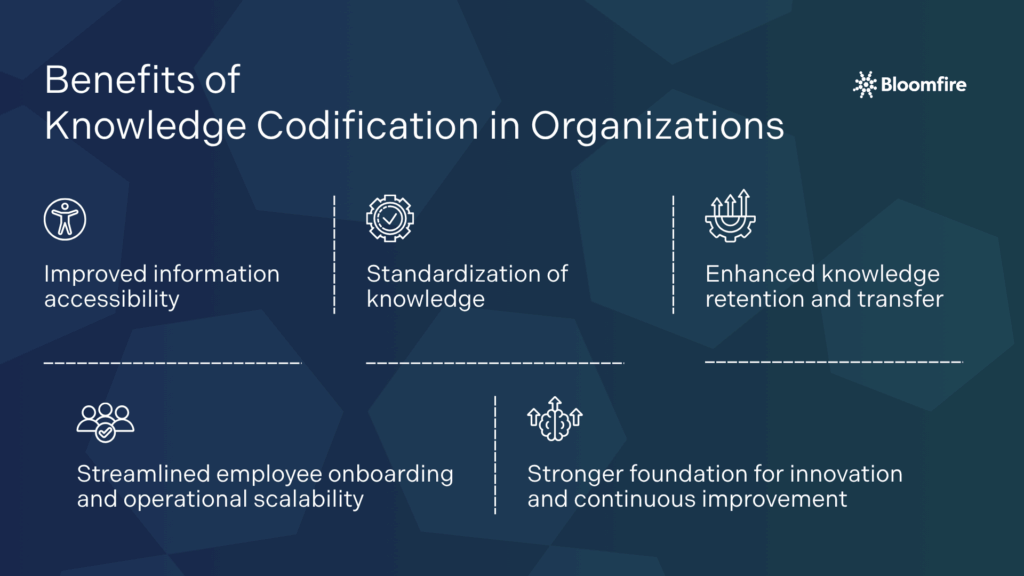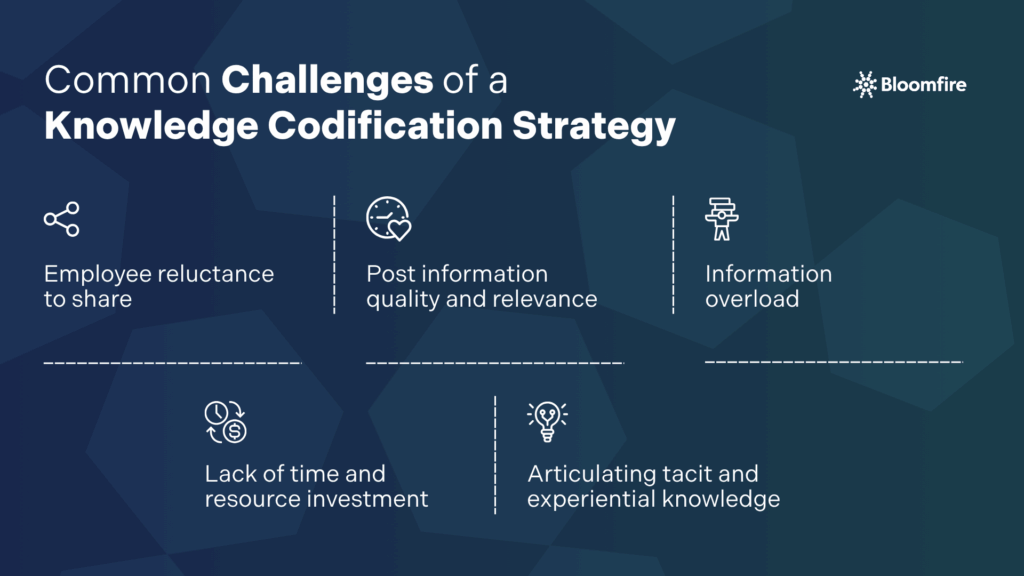Developing a Codification Strategy in Knowledge Management: A Comprehensive Guide

Strategic knowledge management (KM) is a cornerstone of competitive advantage in today’s business environment. Codification in knowledge management, a method of organizing and systematizing information for easy access, has become increasingly crucial for companies across various sectors. This process transforms tacit, often siloed knowledge into explicit, documented resources readily available to all employees.
Implementing a codification strategy in knowledge management benefits industries such as business services, manufacturing, and finance. These sectors face the dual challenge of managing vast amounts of complex information while ensuring that knowledge is accessible and actionable.
As we explore the intricacies of developing a codification strategy, we’ll unveil how it enhances operational efficiency and positions businesses for sustained growth in an increasingly competitive landscape.
Codify Knowledge Like a Pro!
Bloomfire makes team knowledge easy to codify, find, and use. Learn how.
Get a Demo
What Is Knowledge Codification?
At its foundation, knowledge codification involves the systematic arrangement and storage of information and knowledge, making it easily retrievable and usable. This process is about converting tacit knowledge—personal, context-specific insights and experiences—into explicit knowledge that is documented and shared.
Stewart & Shamsie emphasize the importance of this transformation, noting, “Creating and maintaining high-quality codified knowledge requires time, resources, and a strong knowledge-sharing culture.” This highlights the need for a supportive organizational culture that values and actively engages in knowledge management, underscoring the investment in resources and cultural adaptation essential for codification strategies to succeed.
Such strategies are particularly crucial for organizations in the business services, manufacturing, and finance sectors, where the complexity and volume of knowledge demand robust management solutions.
What Are the Benefits of Codification in Knowledge Management?
Embracing a codification strategy in knowledge management is more than just organizing information; it is a comprehensive approach to managing knowledge. It represents a strategic investment in an organization’s enterprise intelligence, resilience, and operational excellence.
Companies can cultivate a more agile, informed, and productive working environment. It paves the way for sustained growth and a distinct competitive advantage in their field.

The primary advantages of adopting a knowledge codification strategy include:
- Improved information accessibility: Knowledge becomes readily available and easily retrievable for all employees when codified. This reduces the time individuals spend searching for essential data or expertise. Thus, it streamlines workflows and enables faster, more informed decision-making.
- Standardization of knowledge across the organization: As codification ensures everyone has access to the same validated information, it helps maintain consistency in processes, practices, and service delivery. Organizations can uphold quality standards, minimize errors, and ensure alignment in common procedures and organizational goals.
- Enhanced knowledge retention and transfer: Organizations can effectively prevent the loss of valuable institutional knowledge even when employees depart or transition to new roles. By utilizing the documented critical insights, best practices, and operational expertise, employees gain the necessary support to enhance their performance.
- Streamlined employee onboarding and operational scalability: With institutional knowledge preserved, onboarding new employees becomes more efficient, relying less on individual mentors. This knowledge base also provides a solid foundation for scaling operations, as successful systems and proven solutions can be replicated with greater reliability and consistency.
- Stronger foundation for innovation and continuous improvement: When existing knowledge, solutions, and operational procedures are well-codified, they provide a clear and transparent baseline. You can identify areas for enhancement, build upon existing successes, and contribute to a culture of innovation and continuous improvement. This eliminates the need to reinvent the wheel.
Evidence continues to confirm these advantages. A study by Deloitte found that companies with effective knowledge management practices see a 5% higher productivity than those without, demonstrating the tangible impact of codification on operational efficiency. The endeavor to codify knowledge, especially tacit knowledge, is fraught with challenges.
Nonaka & Takeuchi capture the essence of this difficulty: “Tacit knowledge, such as intuition and experience, is difficult to codify and may lose its nuance in the process.” This observation points to the nuanced challenge of preserving the depth and richness of personal expertise when translating it into a structured, shared format.
Moreover, according to Bloomfire’s Value of Enterprise Intelligence, the tacit knowledge value of a single employee at the 3PL company is $15,573 per employee. For 575 employees, the value of their collective knowledge is $8.9 million.
The implication is clear: effective codification requires a balanced approach that honors the intrinsic value of tacit knowledge while leveraging the organizational benefits of explicit documentation.
The Practical Advantage of Knowledge Codification in The Digital Age
The digital age has escalated the importance of codification, transforming it from a strategic advantage to a necessity. As organizations grow, capturing, storing, and retrieving knowledge becomes more daunting.
Without a solid framework for codification, valuable insights can become inaccessible, resulting in inefficiencies, missed opportunities, and increased risks. Moreover, in large organizations where the workforce is often dispersed across geographies, ensuring everyone has access to the same level of knowledge is paramount for improved decision-making and operations.
A survey by the American Productivity & Quality Center found that 87% of organizations adopting KMS (which relies on codified knowledge) reported improved communication across departments. It resulted in a 50% faster decision-making process.
AI’s Role in Modern Knowledge Codification
The integration of artificial intelligence (AI) into knowledge codification processes brings transformative benefits. These benefits include increased speed in capturing and organizing knowledge, improved accuracy in tagging and classification, and enhanced discoverability through personalized and context-aware retrieval.
AI introduces automation and intelligent processing capabilities that can handle vast datasets and understand nuances in human language. It can also identify patterns that might be missed by manual efforts, thereby making the entire knowledge codification lifecycle more dynamic and effective.
Furthermore, AI can help unearth hidden insights from existing data and support better decision-making by providing real-time analytics. It can even aid in the challenging task of externalizing different types of knowledge by identifying experts and patterns in their work.
What Are The Common Challenges of a Codification Strategy in Knowledge Management?
Like any organizational initiative, the codification of knowledge may come with issues that your team should be prepared for. Recognizing these common challenges proactively allows organizations to devise effective strategies for a more fruitful and sustainable knowledge management implementation.

Here are five notable challenges that organizations often encounter when codifying knowledge:
- Employee reluctance to share: A primary hurdle involves employees’ hesitation to contribute their knowledge and expertise. This issue often stems from a lack of trust, fear of job redundancy, or insufficient understanding of the initiative’s benefits.
- Post information quality and relevance: Codified knowledge can quickly become outdated or irrelevant if not properly managed. As a result, employees may become confused, which can breed mistrust in the system and lead to operational inefficiencies.
- Information overload: The sheer volume and often intricate nature of organizational knowledge can make its initial capture and ongoing management seem daunting. Managing information overload requires careful planning, particularly when it involves large datasets.
- Lack of time and resource investment: The process of effectively identifying, capturing, and structuring knowledge demands a considerable upfront investment of time from subject matter experts. Additionally, it requires financial resources to acquire appropriate tools, training, and personnel.
- Articulating tacit and experiential knowledge: A significant challenge lies in capturing valuable tacit knowledge. You can employ mentorship programs, storytelling sessions, expert interviews, or communities of practice to translate deep expertise into shareable formats.
Strategic mitigation of these potential difficulties helps realize the full potential of a knowledge codification strategy. Thoughtful planning, coupled with sustained effort and commitment from all levels of the organization, will pave the way for a truly effective system. One that significantly enhances an organization’s knowledge management capabilities and contributes to its overall success.
Overcoming Challenges with a Knowledge Management System
The path to effective codification is filled with challenges. For business services companies, it may be the rapid evolution of industry standards and practices; for manufacturers, it is the detailed documentation of processes and compliance requirements; and in finance, the stringent need for accuracy and regulatory adherence. Each sector faces unique hurdles in knowledge management, necessitating a flexible yet powerful solution.
Enter a knowledge management solution like Bloomfire, a platform designed to bridge these gaps in knowledge management. Bloomfire facilitates codification, offering tools that allow organizations to capture tacit knowledge in virtually any format—documents, videos, articles, or more—categorize and tag content for effortless discovery, and maintain an up-to-date, accessible knowledge base. With its centralized, searchable repository powered by enterprise search, Bloomfire simplifies information retrieval and significantly enhances knowledge sharing and collaboration.
This KM capability ensures that employees can quickly pull the specific knowledge they need, when they need it, from a comprehensive array of formats, addressing the day-to-day challenges of codification and pushing the boundaries of organizational efficiency and growth.
Key Components of a Successful Codification Strategy
Several key components must be considered to ensure the effectiveness of your codification strategy. These include identifying the knowledge to be codified, selecting appropriate tools and technologies, and establishing clear protocols for maintaining and updating the codified knowledge.
- Identification of knowledge: Determine which areas are critical to your organization’s success. Focus on capturing information that is valuable, reusable, and relevant to your team’s objectives.
- Selection of tools and technologies: Choose tools and platforms that facilitate the easy documentation, storage, and retrieval of knowledge. Use knowledge management systems, databases, or cloud-based solutions to ensure accessibility and scalability.
- Establishing protocols: Develop guidelines for the documentation process, including standards for formatting, updating, and maintaining a knowledge base. This ensures the consistency and reliability of the information.
Integrating these essential components into your codification strategy forges a robust system to capture, organize, and manage your organization’s valuable knowledge assets. Such a well-structured system becomes a cornerstone for sustained organizational learning, enhanced agility, and developing a significant competitive advantage in your field.
How to Develop an Effective Codification Strategy
Developing an effective codification strategy requires a systematic approach. The following steps will guide you in formulating a tailored strategy perfectly aligned with your organization’s knowledge management goals and objectives. Engaging thoroughly with these stages will help you build a system that delivers tangible organizational benefits.

1. Assess your current knowledge management practices
Begin by evaluating your existing knowledge management processes to identify areas for improvement. Determine which knowledge areas are most critical and where gaps exist.
2. Define your objectives
Clearly outline the goals of your codification strategy. Consider what you hope to achieve, such as improved information accessibility, enhanced collaboration, or increased knowledge retention.
3. Select appropriate tools and technologies
Choose tools that align with your objectives and facilitate the documentation and sharing of knowledge. Ensure that these tools are user-friendly and scalable to accommodate future growth and expansion.
4. Develop documentation standards
Establish guidelines for how knowledge should be documented, including formats, templates, and protocols for updating and maintaining information. This structured approach ensures all contributions meet consistent quality standards and remain valuable assets to the organization.
5. Implement and monitor your strategy
Roll out your codification strategy and monitor its effectiveness. Gather feedback from employees to identify areas for improvement and make necessary adjustments.
When following this approach, you will not only streamline how information is utilized but also cultivate a more resilient and informed workforce. Applying these steps will enable your organization to construct a comprehensive codification strategy, significantly elevating its knowledge management capabilities.
Knowledge Codification Example: Real-World Applications
Understanding the concept and meaning of knowledge codification is one thing, but seeing it come to life through real-world examples can underscore its value within an organizational setting.
For example, a healthcare organization used codification to develop a comprehensive database of medical procedures and treatment protocols. This resource enabled healthcare professionals to access up-to-date information, improving patient care and outcomes.
This repository included detailed process documentation, best practices, and technical guidelines, enabling team members to locate the information needed to perform their tasks efficiently. As a result, the organization experienced increased productivity, improved communication, and enhanced collaboration across its departments.
The Role of Codification in Business Services and Manufacturing
Implementing a codification strategy can have transformative effects in business services and manufacturing, where the workforce often exceeds 1000 employees.
For instance, a multinational manufacturing firm with a KM system utilized codification to streamline its technical knowledge base, making detailed process guidelines and compliance procedures accessible to employees across all its facilities. This initiative reduced the time required to onboard new engineers and minimized errors in production, demonstrating its impact on operational efficiency.

Similarly, a large consulting firm adopted codification in the business service knowledge management to manage its vast repository of case studies, research papers, and industry analyses. By codifying this knowledge, consultants could swiftly access relevant information, enhancing the quality of client recommendations and fostering innovation in strategy formulation.
Having immediate access to a well-organized and comprehensive knowledge base enabled decision-makers within the consulting firm to adapt swiftly to market changes, significantly contributing to its growth and sustaining its competitive advantage.

These examples illustrate how codification streamlines internal processes and fosters innovation and strategic decision-making in large organizations. Companies can harness the full potential of their enterprise intelligence, ultimately leading to improved performance and competitive advantage.
Impact of Codification Strategy in Finance Companies
Finance companies, particularly those with expansive teams, navigate a complex landscape marked by stringent regulatory compliance and the imperative of risk management. The unique needs of these entities are met through a comprehensive codification strategy.
Such an approach is pivotal in ensuring that critical regulatory guidelines, financial models, and risk assessment protocols are systematically organized and universally accessible. This not only aids in maintaining legal compliance but also enhances the efficiency and accuracy of risk management practices.

Implementing KM software within this context revolutionizes knowledge sharing and management. For example, a global financial institution leveraging Bloomfire for its codification needs enables its workforce to access up-to-date compliance regulations and best practices. This accessibility ensures that team members consistently understand regulatory expectations and risk frameworks regardless of their geographical location or department.
Moreover, Bloomfire’s robust search capabilities and intuitive organization mean that even the most specific financial knowledge is just a few clicks away. It significantly reduces the time spent searching for information and elevates finance companies’ overall operational efficiency.
Through strategic codification, finance companies utilizing a knowledge management (KM) system can strike a harmonious balance between rigorous compliance requirements and the dynamic needs of risk management, ensuring they remain resilient and responsive in a fast-paced financial environment.
Enhancing Customer Support Through Codification
Adopting codification strategies marks a significant leap toward operational excellence for businesses with extensive customer support teams. By systematically organizing a vast repository of FAQs, troubleshooting guides, product information, and resolution procedures, these companies can drastically improve the efficiency and accuracy of their customer support operations.
For large customer support teams, the benefits of codification are transformative. It enables swift access to information, ensuring consistent, accurate responses, and empowers employees to deliver exceptional service.
A well-implemented codification strategy, supported by platforms like Bloomfire, streamlines operations and fosters a culture of knowledge sharing and collaboration.
Real-World Knowledge Codification Example in Customer Support
A compelling example of the success that can be achieved through implementing codification is provided by Orvis, an outdoor and sporting goods retail company. After launching Bloomfire, Orvis saw its first-call resolution rates double, a testament to the efficiency gains from having a well-organized, accessible knowledge base.
Additionally, the company achieved a 100% answer rate for questions posed within the platform, indicating the comprehensive and effective coverage of its knowledge management strategy. This success story highlights the profound impact that a well-executed codification strategy can have on enhancing the quality of customer service, demonstrating Bloomfire’s ability to transform customer support teams into highly efficient units.
By strategically implementing knowledge management practices, companies like Orvis have transformed their customer support operations, fostering loyalty and trust among their customer base. Such achievements highlight the potential for business services companies to reach new heights in operational excellence and customer satisfaction through codification.
Frequently Asked Questions
What is the goal of codification?
The primary goal of knowledge codification is to transform individual, often tacit, expertise and valuable information into explicit, structured, and reusable organizational assets. This conversion aims to make critical knowledge more accessible, shareable, and easier to preserve.
What is an example of codified knowledge?
A prime example of codified knowledge is a company’s Standard Operating Procedure (SOP) for a specific task, such as processing customer returns or onboarding a new client. This document clearly outlines each required step, decision point, and expected outcome, ensuring consistency and enabling knowledge transfer across the organization.
What is the codification approach in knowledge management?
The codification approach in knowledge management focuses on systematically converting individual and organizational knowledge, including expertise and best practices, into explicit, documented formats. This process involves capturing valuable information, then structuring and storing it within accessible systems, such as databases, intranets, or procedural manuals.
How can organizations balance codification and personalization?
Balancing codification and personalization in knowledge management strategies involves leveraging structured knowledge and individual expertise. Encourage employees to share their insights while maintaining a centralized repository of documented knowledge.
Unlocking Growth with Codification: A Strategic Imperative
The strategic implementation of codification in knowledge management across various sectors—business services, manufacturing, and finance—underscores its pivotal role in enhancing operational efficiency, innovation, and decision-making.
Platforms like Bloomfire play an instrumental role, simplifying the codification process to ensure knowledge is preserved and made easily accessible, thereby enhancing employee engagement, customer satisfaction, and innovation rates. This compelling evidence invites businesses to have a focused codification strategy to revolutionize their operations, urging them to leverage knowledge management for sustainable growth and competitive advantage in the digital age.
This blog post was originally published in February 2024 and updated in May 2025.
See Codification in Action
Embrace codification as your strategic advantage. See how Bloomfire can make it a reality for your business.
Take a Test Drive

A SharePoint Alternative That Unlocks Enterprise Intelligence

What Is Enterprise AI Search? (And Why Your Business Needs It)

The Value in Knowledge Sharing Sessions

Start working smarter with Bloomfire
See how Bloomfire helps companies find information, create insights, and maximize value of their most important knowledge.

Take a self guided Tour
See Bloomfire in action across several potential configurations. Imagine the potential of your team when they stop searching and start finding critical knowledge.